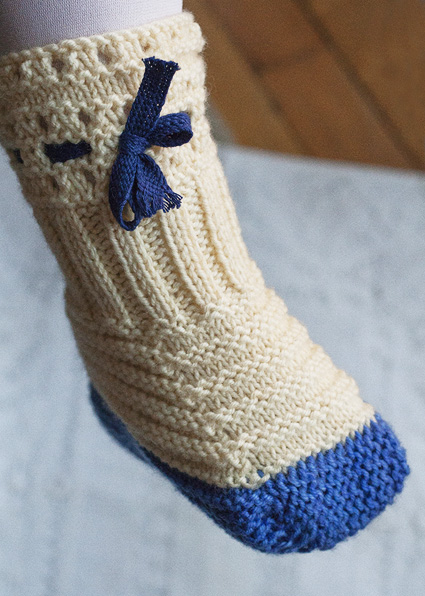

|
 Translated by Franklin Habit from Mrs Beeton's Book of Needlework (1870)
|
|
| Tweet | |
| SIZE |
Toddler |
|
FINISHED MEASUREMENTS |
Shoe: 5 inches measured heel to toe |
|
MATERIALS Notions |
| GAUGE |
24 sts/48 rows = 4 inches in garter stitch |
|
PATTERN NOTES |
Method Historic Colors Ribbon Substitute M1 (make one) Cable Cast-On. The method for the Cable Cast On may be found here. Pick up and knit (pu and k). This technique is described here. Mattress Stitch. This technique is described here. |
|
DIRECTIONS |
Sole (first side) Repeat Rows 1-2 10 more times. 33 sts. Knit one row. Working yarn will be at the heel (unshaped) edge of the work. Toe Increases: Repeat Rows 3-4 5 more times. 11 sts. Repeat Rows 1-2 4 more times, then work Row 1 once more. 5 sts. Working yarn will be at the unshaped edge of the work. Turn work. Use cable cast-on to CO 28 sts. 33 sts. Sole (second side) Repeat Rows 1-2 10 more times. (22 sts) Knit one row. Instep Knit 1 row (WS). Row 1 [RS]: K to 2 sts before marker, k2tog, sl marker, k12, sl marker, k2tog, k to end. 2 sts decreased. Repeat Rows 1-4 4 more times, until 48 sts remain, ending with Row 4. Leg Ribbing row: [K2, p2] to end. Knit 3 rows. First eyelet open row [WS]: [P2tog, p1, yo] to last 3 sts, p2tog, p1. 47 sts. Second open row [WS]: [P2tog, p1, yo] to last 2 sts, p2. Third open row [WS]: [P2tog, p1, yo] to last 2 sts, p2. Knit 3 rows. Purl 1 row. Knit 3 rows. Final open row [RS]: [P2tog, p1, yo] to last 2 sts, p2. BO. Cut working yarn, leaving a long tail that will be conveniently located for sewing up the leg of your sock. FINISHING Align tip of shaped toe with sole seam, and stitch two toe seams as indicated in photo. Weave in ends. Wash and gently block. Run ribbon through Second open row and tie bow at front of leg. |
| ABOUT THE DESIGNER |
| Franklin Habit is the author of It Itches: A Stash of Knitting Cartoons(Interweave Press) and proprietor of the popular knitting blog, The Panopticon. He travels widely to teach knitting and photography, and his work appears with shocking regularity in perfectly respectable fiber arts magazines and books. If you manage to get these things onto the feet of actual children, he'd like to see pictures. |
| Pattern & images © 2013. Franklin Habit. |